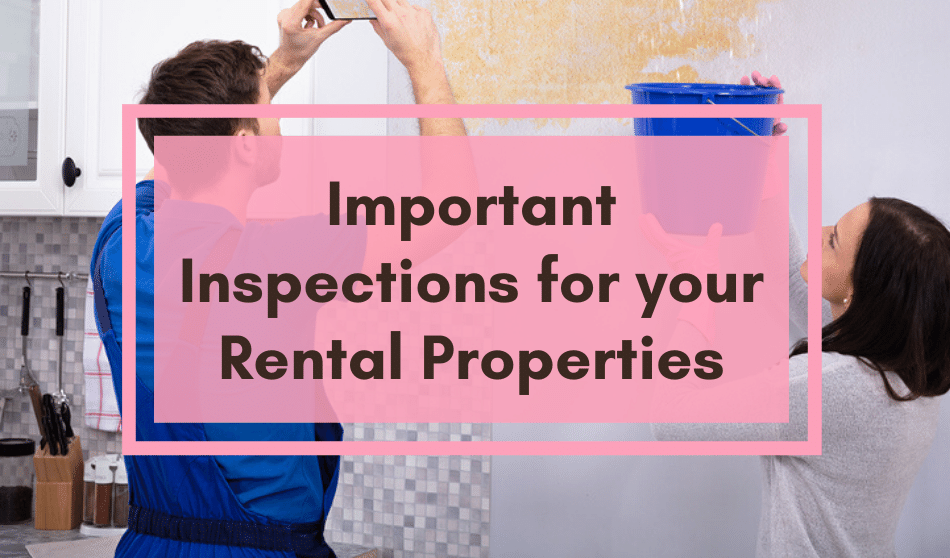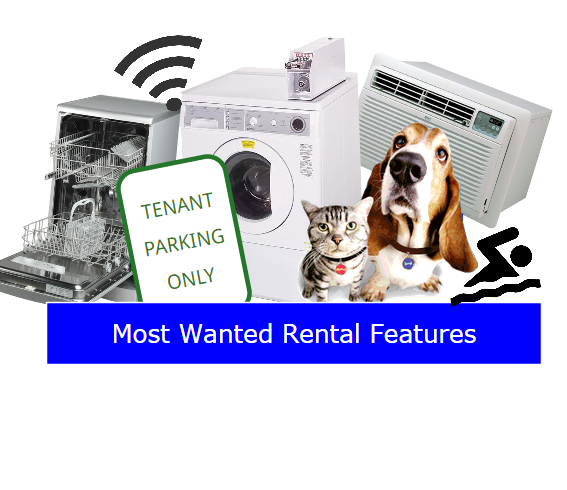
Maintaining a residential property requires active care and preventive maintenance to ensure the longevity of your home. In the case of rental housing, most owners do not live onsite and rely on tenants and management to maintain the condition of their investment property.
Despite one’s best effort to screen applicants in order to find the most qualified tenants, great credit scores, and on-time rent payments do not always reflect great home maintenance behavior. In fact, a lot of renters find one of the perks of rental housing includes the ability to defer home maintenance responsibilities to property managers and owners.
The best way to ensure your rental property is properly maintained and in great condition is to conduct regular inspections. Inspections provide 2 key benefits to rental property owners.
Benefits of Conducting Rental Property Inspections
- You will identify any maintenance issues that need to be fixed before they become expensive problems.
- You can make sure your tenants are following lease terms and taking care of tenant required maintenance.
Types of Inspections for Rentals
If you self-manage your rental properties you should be prepared to conduct 4 types of inspections, these include routine inspections and those related to the beginning and end of a lease term. If you use a property management company to manage your rental properties, you should verify that they plan on conducting similar types of inspections which should be outlined in your management agreement.
Make sure to keep excellent records of your inspections, including notes with dates and pictures. Inspection reports and paperwork help you keep track of the condition of your property, and can also serve as legal documents if anything happens to your rental home. Keep inspection reports and maintenance files stored electronically in your property management software account, which should provide unlimited cloud-based storage options linked directly to a property or a tenant for easy access and reference.
For an added bonus, look for a property management software that connects you with a mobile inspection app to make rental property inspections convenient for you, your team, and your tenants.
Mobile Inspection App for Self-Guided Inspections
Property managers and landlords are using mobile inspection apps, like zInspector, to help tenants safely complete important inspections for their rental properties. With a mobile inspection app, your tenants can use their phones to go through an inspection checklist and even take real-time pictures in the app that will be added to the inspection report. A self-guided inspection is the easiest way to keep your tenants, team, and properties safe during social distancing.
Once an inspection is complete a report is created for you to review and store for your records. You can keep a copy of the report in your property management software account and create a work order for your maintenance team based on information in the report.
The mobile inspection app can be used by you, your team, your maintenance vendors and your tenants to help keep your properties well maintained. It serves as an essential tool for completing important inspections for your rental properties.
Move- In Inspection –
- Each lease term should begin with a move-in inspection conducted by you and your tenants. Move-in inspections document the condition of your property at the start of tenancy so you have a dated reference for any damage to the property, beyond normal wear and tear. Every room, wall, floor, window, door, appliance, faucet, light fixture, window treatment, etc. should be reviewed to ensure it is working properly. Any scuffs, dents, thumb tack holes, (really, anything big or small) should be recorded and photographed.
- Inspection checklists allow you to rate the condition of everything at the property and take detailed notes. Both you and your tenants should sign and date the move-in inspection report to indicate mutual agreement about the condition of the property at move-in. You will use your move-in inspection report during move-out to determine if any of the tenant’s deposit will be retained for cleaning or repairs.
Move-Out Inspection –
- The move-out inspection is your opportunity to determine the overall condition of the property when your tenant moves out. As part of your lease agreement, your tenant should understand they are expected to return the property in the same condition as they received it when moving in. Your move-out inspection should reference your move-in inspection report and notes should be made about how the property compares to its condition at the start of the tenancy and what needs to be done in order to return the property to rent-ready condition, including repairs and cleaning. Any tenant caused damage or cleaning, beyond normal wear and tear, can be deducted from your tenant’s security deposit. Conducting a move-out inspection with your tenant is a great way to avoid tenant disputes over any deductions you made to their security deposit refund.
Seasonal Inspection –
- Seasonal inspections go hand and hand with seasonal maintenance. Each season calls for exterior and interior preventative maintenance at your property, like cleaning gutters every fall or weatherizing water pipes in the winter. Since you will be on the property for seasonal maintenance, it is the perfect time to conduct a routine inspection. Seasonal inspections allow you to ensure lease compliance and assess the property for any needed repairs. An inspection can give you a chance to offer helpful pointers to your tenants about things they could be doing differently to take better care of the unit (remind them that proper care will help them get their security deposit back when they vacate). Inspect the interior and exterior of the property to make sure everything is in great condition. Program reminders in your property management software for seasonal inspections and maintenance.
Drive-By Inspection –
- Simply driving by your property in between seasonal inspections allows you to check on the condition of your property without needing to coordinate schedules with your tenants. A drive-by inspection can reveal unauthorized pets, long-term guests, or other lease violations that a tenant wasn’t able to hide from you since they were unaware of your visit. You do not need to give your tenants notice before conducting drive-by inspections if you do not enter the interior, but remember if you do drive-bys too often, you could disrupt your tenant’s right to quiet enjoyment and their privacy. Nosy or intrusive landlords will likely annoy their tenants and hurt their chances of long-term tenancy. If you notice any issues that need to be addressed during your drive-by be sure to notify your tenant in writing and offer ways for how they need to fix the problem.
Other types of inspections
Beyond the inspections listed above, here are some additional types of inspections rental property owners should be aware of:
Pre-Move-out Inspection:
In order to streamline turnover, some management companies conduct pre-move-out inspections. Pre-move-out inspections typically happen within the 30 days prior to move-out. A pre-move-out inspection allows management to point out what a tenant needs to do in order to return the property back to move-in condition. This can include cleaning and any repairs a tenant can do to prevent you from withholding their security deposit.
Pre-move-out inspections are beneficial to management as they provide insight about how much time, money, and types of repairs or cleaning they will need to be prepared for in order to make the rental move-in ready for the next lease.
Pre-Management Inspection:
If you choose to hire a property management company to manage your rental, you should inspect your property together from top to bottom as part of your pre-agreement terms. This should be an extremely thorough inspection so your management firm has proper knowledge of the condition of your property, including the age of appliances and major fixtures before they start managing it.
They should have an excellent understanding of city codes and renter rights for what you need to provide tenants as a rental property owner and advise you on how to meet these standards. Your pre-management inspection will give both you and your new property manager an idea of work your property needs in order to have it rent ready.
Pre-purchase Inspection:
If you’re planning to purchase an investment property always get it inspected (which is generally required when obtaining financing). Property inspections will give you the information that you need to calculate for future expenses like the age of the roof, windows, heating system etc. These major property fixtures all have a lifespan and if they are nearing the end you will need to budget and plan for replacing those items.
Knowing the condition of the home will also give you the information for negotiating the price. If a lot of work is going to be needed in the near future this is a bargaining chip that you need to use when coming up with a price to offer on the home. An inspection may also reveal information that will tell you if you should walk (or run) away from a home. If the property has foundation issues, outdated electrical, or plumbing it may be better to continue your search.
Bonus: Other tips to help maintain your properties during tenancy.
- Monitor Important Appliances and property fixtures. Service large appliances regularly to prevent damage from poor operation. Trying to save money on appliances can cost you more in the long run when something eventually breaks or requires emergency maintenance. Important appliances and fixtures to pay attention to include: roof, HVAC system, exterior paint, windows, fridge, dishwasher, oven/stove, water heater, washer/dryer.
- Provide a small cleaning kit upon move-in; all-purpose cleaner, bleach, and sponges are good items to include. Giving your tenant a welcome package at the beginning of a lease is a great way to establish a good relationship with your tenant from the start and including cleaning supplies helps empower your tenant to keep the property clean. A clean house will help your tenants notice maintenance issues faster and can help prevent pest problems.
- Take maintenance requests seriously and respond to them quickly to prevent costly repairs -fixing a leaky sink is much more affordable than replacing the floor due to water damage.





I read this the other day but now have a new data point. I’ve followed these for years, a little light on ‘inspections’, instead going in and inspecting the structure, function and condition. But, you can’t really gauge how they are doing things. I just reviewed my washer/dryer two months ago and yesterday got photo of it burned (fire dept was called out), it was clearly a lint trap fire (must be removed every load). It was my dryer, too, I’m not going to replace it. It just seems like you gotta teach people everything these days – this is a good, clean woman and I was surprised. Do you suggest an ‘owner’s manual’ for new tenants (don’t heat house with gas stove, don’t stand in bathtop and blowdry your hair, don’t put tongue into AC outlet…?
Yes, I think a maintenance guide for your renters is an excellent idea. For many renters, it might be there first living on their own and they might have never had to deal with normal (obvious) home maintenance care. I cringe at the memory of asking my landlord to come over and flip the circuit breaker for me, when I rented in my young twenties. Anyway, here’s a handy guide for landlords as a starting point to help your tenants be successful
https://www.rentecdirect.com/blog/help-renters-successful-new-renter-maintenance-checklist/
I really appreciate your efforts it was very interesting and useful. Surely your post will help more people. Regular home inspections makes you check for any issues and get them fixed at the right time.
Hi Roy, Glad you found it interesting and useful.
I have daily illegal entry Into my apartment. Things are being stolen. I have reported to management weekly for months yet they do nothing. What can be I do short of the expense of moving?
Sheryl, reach out to your local housing authority to ask what type of notification is needed before a landlord can enter. Be sure to ask them your rights in this situation. As for missing items, if of value you might consider contacting your police department to investigate.